

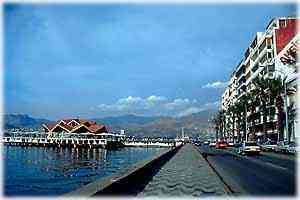 The original city was established in the third millenium B.C., and at that
time shared with Troy the most advanced culture in Western Anatolia. By 1500
B.C. it had fallen under the influence of Central Anatolia's Hittite Empire. In
the first millenium B.C., Izmir, then known as Smyrna, ranked as one of the
important cities of the Ionian Federation; during this period -- one of the
city's most brilliant -- it is believed that Homer lived here. The Lydian
conquest of the city, around 600 B.C., brought this period to an end, and Izmir
remained little more than a village throughout the Lydian and the subsequent 6th
century B.C. Persian rule. In the fourth century B.C. a new city was built at
the instigation of Alexander the Great on the slopes of Mount Pagos (Kadifekale).
Izmir's Roman period, from the first century B.C., gave birth to its second
great era. Byzantine rule followed in the fourth century and lasted until the
Seljuk conquest of the 11th century. In 1415, under Sultan Mehmet Celebi, Izmir
became part of the Ottoman Empire.
The original city was established in the third millenium B.C., and at that
time shared with Troy the most advanced culture in Western Anatolia. By 1500
B.C. it had fallen under the influence of Central Anatolia's Hittite Empire. In
the first millenium B.C., Izmir, then known as Smyrna, ranked as one of the
important cities of the Ionian Federation; during this period -- one of the
city's most brilliant -- it is believed that Homer lived here. The Lydian
conquest of the city, around 600 B.C., brought this period to an end, and Izmir
remained little more than a village throughout the Lydian and the subsequent 6th
century B.C. Persian rule. In the fourth century B.C. a new city was built at
the instigation of Alexander the Great on the slopes of Mount Pagos (Kadifekale).
Izmir's Roman period, from the first century B.C., gave birth to its second
great era. Byzantine rule followed in the fourth century and lasted until the
Seljuk conquest of the 11th century. In 1415, under Sultan Mehmet Celebi, Izmir
became part of the Ottoman Empire.
The 3rd largest, and one of the most beautiful provinces of Turkey is Izmir, extending on the shores of an attractive bay, filled with ships and yachts. Backed by mountains and facing the sea, this site offers a fine appearance, both with its natural panorama and its modern and orderly view. Lovely palm trees decorate the promenades and avenues, where new and impressive buildings stand.
Walking around this charming city, one can see a lot, ranging from the oldest remains, to the most recent establishments scattered around.
The clocktower stands in Konak Square as a symbol of the city while nearby the Archelogical Museum houses many finds from the early western Anatolian civilizations. In the city center, there is the Kultur Park (Culture Park) where the famous annual International Fair is held.
Filled with pretty restaurants, cafes, shops and bars, Kordonboyu is a long promenade, which provides a restful atmosphere and the typical elegant scenery of the city. Kemeralti Bazaar is a smart place with limitless shopping opportunities for here you will find almost anything you want, at the most appropriate prices.
Karsiyaka is another attractive district on the opposite side of the bay, where the Olaf Palme Park exists near the open-air museum, which houses many interesting statues.
Known as "Smyrna" in ancient
times, the province of Izmir has a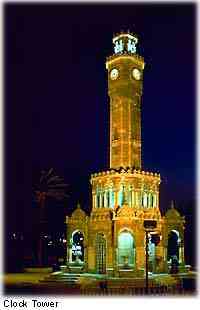 long history, dating back to the 3rd-
millenium BC when it was one of the most advanced cultural center in Western
Anatolia. Legendary Homer lived here in the lonian period, which was the most
splendid age of the city, dating to the 1st-millenium BC. Today some beautiful
examples from this long past can be found inside the city. Here is the
Kadifekale (the Velvet Fortress) located on Mount Pagos, overlooking the area. A
marvellous view of the Gulf of Izmir is provided from this castle built in the
3rd-century BC, and later restored at various times. Another important sight is
the Roman agora, constructed during one of the most brilliant periods of the
province. The seven churches mentioned by St. John in the Book of Revelation are
also in Turkey and are spread around Izmir, which are Izmir (Smyrna), Efes
(Ephesus), Eskihisar (Laodicea), Alasehir (Philadelphia), Sart (Sardis), Akhisar
(Thyatira), and Bergama (Pergamum).
long history, dating back to the 3rd-
millenium BC when it was one of the most advanced cultural center in Western
Anatolia. Legendary Homer lived here in the lonian period, which was the most
splendid age of the city, dating to the 1st-millenium BC. Today some beautiful
examples from this long past can be found inside the city. Here is the
Kadifekale (the Velvet Fortress) located on Mount Pagos, overlooking the area. A
marvellous view of the Gulf of Izmir is provided from this castle built in the
3rd-century BC, and later restored at various times. Another important sight is
the Roman agora, constructed during one of the most brilliant periods of the
province. The seven churches mentioned by St. John in the Book of Revelation are
also in Turkey and are spread around Izmir, which are Izmir (Smyrna), Efes
(Ephesus), Eskihisar (Laodicea), Alasehir (Philadelphia), Sart (Sardis), Akhisar
(Thyatira), and Bergama (Pergamum).
Today, Izmir has an important port, as well as a lovely holiday resort with numerous sandy beaches stretching over its towns and environs. In addition to famous sites like Efes, Kusadasi or Cesme, Izmir possesses Balcova, one of the important thermal centres in Turkey, which is known as the "Agamemnon Baths". They offer modern facilities to visitors, in the midst of wonderful surroundings.
BERGAMA (PERGAMUM)
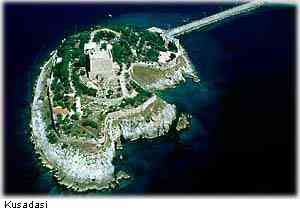 Pergamum,
(105 kms north of Izmir)~~ is one of the major sites antiquity in Turkey, having
been a great center of culture and civilization throughout history. The site has
remarkable remains from the Roman and Byzantine periods. The Asclepion to the
southwest of the lower city, was built to pay homage to the God of Health,
Asclepios, and it was the most celebrated in the world. The temples of Trajan
and Dionysus, majestic Altar of Zeus, the temple of Demeter, inspiring theatre,
the gymnasium, the arsenals, the lower agora and the famous library form the
Acropolis. In addition, you may see the finds from Pergamum and the surrounding
area. In the Archaeological and Ethnographical Museum. The temple of Serapis,
also called the "Red Courtyard" due to its red tiles, is today located
within the town of Bergama. It was built as a sanctuary dedicated to Serapis and
was then converted into a basilica by the Byzantines. Bergama is the homeland of
many philosophers and scientists. Among them is Krates who invented and produced
the "parchment paper" (Pergamene Kaste) here.
Pergamum,
(105 kms north of Izmir)~~ is one of the major sites antiquity in Turkey, having
been a great center of culture and civilization throughout history. The site has
remarkable remains from the Roman and Byzantine periods. The Asclepion to the
southwest of the lower city, was built to pay homage to the God of Health,
Asclepios, and it was the most celebrated in the world. The temples of Trajan
and Dionysus, majestic Altar of Zeus, the temple of Demeter, inspiring theatre,
the gymnasium, the arsenals, the lower agora and the famous library form the
Acropolis. In addition, you may see the finds from Pergamum and the surrounding
area. In the Archaeological and Ethnographical Museum. The temple of Serapis,
also called the "Red Courtyard" due to its red tiles, is today located
within the town of Bergama. It was built as a sanctuary dedicated to Serapis and
was then converted into a basilica by the Byzantines. Bergama is the homeland of
many philosophers and scientists. Among them is Krates who invented and produced
the "parchment paper" (Pergamene Kaste) here.
Dikili is a harbor town close to Bergama, visited by cruise liners bringing visitors to Pergamum. Dikili is an ideal place to relax after a Pergamum excursion. A walk along the Rordan promenade is a pleasure. Between Dikili and Izmir do not forget to visit the port of Candaril which is crowned with one of the best preserved Genoese fortresses .
THE CESME PENINSULA
Cesme
is a little town at the tip of the peninsula that forms the Gulf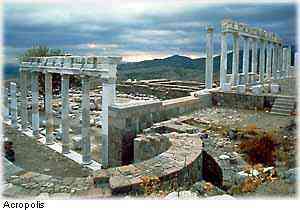 of Izmir. The
meaning of "Cesme" is "fountain" or "spring" due
to the curative springs and thermal baths around especially in Ilica. Cesme and
Ilica are resorts that should be visited for a while because of the vast white
beaches and azure waters with seasonal accommodation facilities. Ilica is
located at the center of several touristic sites. Thermal resorts of Sifne Pasa
Limani, Buyuk Liman, Alacati, and the Bay of Boyalik. You may enjoy almost every
kind of water sport in Cesme, including underwater diving. If you are lucky
enough you may encounter the seals, off the shore. In this town, there are
excellent accommodation facilities and an attractive night life. Cesme Castle
now houses the International Cesme Sea and Music Festival. The Cesme Peninsula
has many seaside resorts. At the northeast of Cesme lies lidin which was the
important port of Erythrai, founded after the War of Troy, and it has a good
view from the acropolis, overlooking the bay and the islands .
of Izmir. The
meaning of "Cesme" is "fountain" or "spring" due
to the curative springs and thermal baths around especially in Ilica. Cesme and
Ilica are resorts that should be visited for a while because of the vast white
beaches and azure waters with seasonal accommodation facilities. Ilica is
located at the center of several touristic sites. Thermal resorts of Sifne Pasa
Limani, Buyuk Liman, Alacati, and the Bay of Boyalik. You may enjoy almost every
kind of water sport in Cesme, including underwater diving. If you are lucky
enough you may encounter the seals, off the shore. In this town, there are
excellent accommodation facilities and an attractive night life. Cesme Castle
now houses the International Cesme Sea and Music Festival. The Cesme Peninsula
has many seaside resorts. At the northeast of Cesme lies lidin which was the
important port of Erythrai, founded after the War of Troy, and it has a good
view from the acropolis, overlooking the bay and the islands .
Urla (Clazomenae) is a peaceful place to visit and to taste the delicious fish at a local seaside restaurant. The view from the Guvendik Hill is always relaxing.
The road between Izmir and Cesme is dotted with lovely little fishing villages such as Mordogan which takes its name from the particular purple color of the sunrise at that spot and Karaburun an unspoiled village nestled between the mountains and picturesque bays Balikliova.
On the southern part of the Peninsula is Seferihisar an important yachting center surrounded by Geneose remains. From here you may visit the ancient city of Teos to see the impressive Temple of Dionysus, or to lose yourself to the warm sandy beaches of Altnkum.
Gumuldur will also tempt you with its beautiful beaches full of tranquil bays, which you may consider as your own, with excellent accommodation, discos and restaurants.
The colossal statute of Apollo in the Temple of Apollon at Ahmetbeyli (Claros), should not be missed as it is an amazing piece of art.
FOÇA
An attractive site with a mysterious nature is Foça, a legendary place interesting sights. Here is the fascinating Siren Rock Island, where the action of the soft wind blowing through the rocks make sounds resembling a woman's cries. These unearthly sounds, once allegedly spell bound sailors to stay on this land until their death.
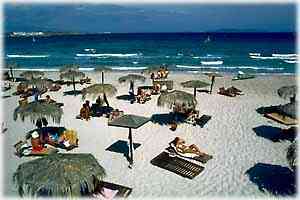 Foça is the ancient Phocaea of the
lonians, and is supposed to have taken its name from the "fok" which
are the Mediterranean seals that inhabited this distinctly peculiar rocky
ground.
Foça is the ancient Phocaea of the
lonians, and is supposed to have taken its name from the "fok" which
are the Mediterranean seals that inhabited this distinctly peculiar rocky
ground.
Reflecting the bright history of the region, several monuments exist, including a tomb of a Persian King, and another called "Seytan Hamami" (Devil's Baths) at the foot of the Candede Hill. Here, the natural beauty is combined with these historical assets, making Foça a charming touristic site.
Today, the town is a lovely holiday village with green covered land meeting the clear blue sea. The numerous modern facilities established around the clean beaches offer visitors a wonderful vacation. A special event for divers, is the Underwater Sports Festival held in the region.
SELCUK-EFES (EPHESUS)
Ephesus proudly houses one of the seven ancient wonders of the world; the Temple of Artemis. The city is dedicated to her and has many fascinating buildings. The precise date of the city's foundation is not known but legend said that the first Efes was founded by Women Warriors of the Amazon in the 14th century BC and later inhabited by lonians in the 11th century BC after the first settlement of the Anatolian's natives, the Lelegians. In a short time the city became very important. After 133 BC it became a Roman province and during the reign of Augustus it became the trade center of Asia.
With all these civilizations passing
through Ephesus, the remains take one or two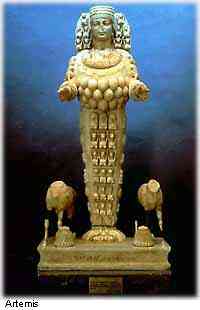 days to visit fully. The city still
retains its importance, but this time as the most important archaeological and
historical city in Turkey. One of the very amazing ruins in Efes is the huge
amphitheatre with a 24,000 seat capacity and superb acoustic effects. Seljuk is
close to Efes and is crowned with a Byzantine citadel and the basilica of St.
John. Next to the basilica is the Seljuk Isa Bey Mosque. The Seven Sleepers'
Cave is another historical place near Efes. The archaeological museum is
significant with its striking collection of items gathered from the excavations
in Ephesus. Every May there is an International Festival in Efes.
On Bulbuldagi (Mt. Nightingale) one
can find the small house built for the Virgin Mary (9 kms from Seljuk) when St.
John brought her to Ephesus after Christ's death. She spent her last days in
that house. Today it is a place of Pilgrimage for Christians and also visited by
Muslims, and is officially sanctioned by the Vatican. Every year on August the
15th, a commemoration ceremony is held there.
days to visit fully. The city still
retains its importance, but this time as the most important archaeological and
historical city in Turkey. One of the very amazing ruins in Efes is the huge
amphitheatre with a 24,000 seat capacity and superb acoustic effects. Seljuk is
close to Efes and is crowned with a Byzantine citadel and the basilica of St.
John. Next to the basilica is the Seljuk Isa Bey Mosque. The Seven Sleepers'
Cave is another historical place near Efes. The archaeological museum is
significant with its striking collection of items gathered from the excavations
in Ephesus. Every May there is an International Festival in Efes.
On Bulbuldagi (Mt. Nightingale) one
can find the small house built for the Virgin Mary (9 kms from Seljuk) when St.
John brought her to Ephesus after Christ's death. She spent her last days in
that house. Today it is a place of Pilgrimage for Christians and also visited by
Muslims, and is officially sanctioned by the Vatican. Every year on August the
15th, a commemoration ceremony is held there.
Known in Turkish as “Beautiful Izmir” the city lies at the head of a long and narrow gulf furrowed by ships and yachts. The climate is mild and in the summer the constant and refreshing sea breezes temper the sun’s heat. Behind the palm-lined promenades and avenues which follow the shoreline, the city, in horizontal terraces, gently the slopes of the surrounding mountains. Izmir is the third largest city in Turkey and its port is second only to Istanbul. A cosmopolitan and lively city all year round, Izmir bursts with an added vibrancy during the International Arts Festival (June\July) and the International Fair (August\Sept).
The original city was established in the third millennium
B.C. (at present day Bayrakli), at which time it shared with Troy the most
advanced culture in Western Anatolia. By 1500 B.C. it had fallen under the
influence of the Central Anatolian Hittite Empire. In the first millennium B.C .Izmir,
then known as Smyrna, ranked as one of the most important cities of the Ionian
Federation. During this period, one of the city’s most brilliant, it is
believed that Homer resided here. Lydian conquest of the city, around 600 B.C.,
brought this period to an end. Izmir remained little more than a village
throughout the Lydian and
 subsequent sixth-century B.C. Persian rule. In the
fourth century B. C. a new city was built on the slopes of Mt. Pagos (Kadifekale)
during the reign of Alexander the Great. Izmir’s Roman period,m beginning in
the first century B.C. was its second great era. Byzantine rule followed in the
fourth century and lasted until the Seljuk conquest in the 11th
century. In 1415, under Sultan Mehmet Celebi, Izmir became part of the Ottoman
Empire.
subsequent sixth-century B.C. Persian rule. In the
fourth century B. C. a new city was built on the slopes of Mt. Pagos (Kadifekale)
during the reign of Alexander the Great. Izmir’s Roman period,m beginning in
the first century B.C. was its second great era. Byzantine rule followed in the
fourth century and lasted until the Seljuk conquest in the 11th
century. In 1415, under Sultan Mehmet Celebi, Izmir became part of the Ottoman
Empire.
The Archeological Museum, near Konak Square, houses a superb collection of antiquities including the statues of Poseidon and Demeter, which, in ancient times, stood in the Agora. (Closed on Mondays)
Next to the Archeology Museum, the Ethnography Museum contains folkloric artifacts, which include a fine collection of Begama and Gordes carpets, traditional costumes and camel bridles. (Closed on Mondays)
The Ataturk Museum is situated on Ataturk Caddesi in an old Izmir house used by the founder of the Turkish Republic. It exhibits photographs of the leader as well as some of his personal effects. (Closed on Mondays)
The Fine Arts Museum, located in Konak, displays the works of famous Turkish painters. (Closed on Mondays)
The Selcuk Yasar Art Museum is a private museum on Cumhuriyet Bulvari with a collection of 20th-century Turkish art. (Closed on Sundays)
The Natural History Museum in Bornova acts as a natural reserve of the Aegean Region landscape’s historical preservation. (Closed on Sundays)
The Odemis Archeological Museum is about 60 km east of Izmir and displays regional artifacts. (Closed on weekends)
The Tire Archeological Museum is about 50 km east of Izmir. (Closed on weekends)
The excavations at Bayrakli have unearthed a temple dedicated to
Athena and the wall of the Ionian city, which
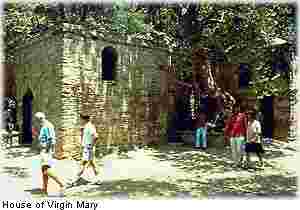 flourished there between the
seventh and fifth centuries B.C. has also been uncovered.
flourished there between the
seventh and fifth centuries B.C. has also been uncovered.
On Kadifekale (Mt. Pagos) stands the impressive ruin of a castle and its walls which were built by Lyimachus in the reign of Alexander the Great, and which still dominate Izmir today. The castle offers an excellent vantage point to enjoy a magnificent view of the Gulf of Izmir.
The Agora, or marketplace, in the Namazgah Quarter was originally constructed during the rule of Alexander the Great. What remains today, however, dates from the rebuilding under Marcus Aurelius after a devastating earthquake in 178 A.D.
The Sirinyer and Yesildere Aqueducts, two examples of Roman engineering spanning the Meles River, supplied Izmir’s water throughout the Byzantine and Ottoman eras.
The Saint Polycarp Church is the oldest church in Izmir and symblozes the Seven Churches of the Apocalypse. Saint Polycarp was martyred at age 86 in A.D. 155 at Kadifkale by the Romans. According to tradition, when they tried to burn him at the stake the flames wouldn’t touch him so they finally stabbed him to death. The church was reconstructed in 1620.
The Kizlaragasi Han (Inn), a fine example of 18th-century Ottoman architecture of the period, is being restored to its former glory.
The symbol of Izmir, the Saat Kulesi, or Clock Tower, stands in the heart of the city at Konak Square. It was a gift from Sultan Abdulmecit, and was built in 1901 in an elaborately decorated late-Ottoman style.
The old Asansor quarter, filled with old restored houses, is also known as the Jewish quarter. Dario Moreno Sokagi is the main pedestrian street to the Asansor itself, which is an elevator that was built in the 19th century. At fifty-one meters in height, it provides access between the lower and upper streets. Situated on the upper side, the Asansor restaurant offers a beautiful view of Izmir.
If you find yourself on Havra Sokak in Kemeralti, be sure to notice the old buildings and synagogues. Alsancak (Punta), with traditionally restored houses, has been converted into a pedestrian promenade with bars, cafes and restaurants.
In the center of Cumhuriyet Meydani, or Republic Square, is the Ataturk Monument, an impressive statue of Ataturk sitting on a horse and facing the sea. Erected in 1933, the monument commemorates the liberation of the city by Turkish forces.
The Flying Dolphins, in Karsiyaka, is a monument that symbolizes friendship and brotherhood.
Hisar Mosque is the largest and oldest in Izmir. Built in the 16th century,
and restored in the 19th century, it has a delightful interior with
an interesting mimber (pulpit) and mihrab (niche showing the direction to
Mecca).
Other mosques in
Izmir are Salepcioglu (20th-century),
Sadirvan (17th-century with 19th-century restorations) and
Kemeralti (17th-century).
All these are situated close to the Kemeralti Quarter.
Kulturpark, the main park of the city, offers a variety of activities. It is the site for the International Izmir Fair and contains an amusement park, zoo, restaurant and quiet gardens.
Olof Palme Park, situated in Karsiyaka, is a relaxing place to stop. It also has sports facilities. Karsiyaka is ancient Cordelia.
Next door, the Adnan Saygun Park, a center for artistic activities, contains an amphitheatre for concerts and theatrical productions, as well as the Open-Air Museum Park, which has statues scattered throughout the grounds.
Insan Haklari (Human Rights) Park has lovely modern statues, including the huge Flying Dolphins Monument.
Muammer Aksoy Park is a lovely seaside park with a nice view of Izmir Bay. Turgut Ozal Recreation Park, located in Bayrakli, offers a number of recreational and sports activities.
For many years Izmir has enjoyed a reputation as a cosmopolitan city of culture. The Izmir Cultural Center hosts opera and ballet performances as well as musical concerts. The city is home to the Aegean Philharmonic Orchestra and boasts a thriving theatrical community. During the annual Izmir International Festival, international and local artists perform at various venues in the city and surrounding area, including the theatre at Ephesus. Take a horse-drawn carriage along the promenade during the day and afterwards spend the evening in the lively atmosphere of the bars and cafes around Kordonboyu, Passport Pier and Karsiyaka.
In the streets of the Kemeralti Market area, it is possible to find fascinating antiques, both fine and fun jewelry, a great variety of clothing, and the dried figs and raisins for which Izmir is famous. The fish restaurants in this colorful area serve up the local specialties of tranca and cipura, two types of sea bream.
The best modern and most elegant shops are on the Kordon Promenades in Alsancak and Karsiyaka and on Cumhuriyet Avenue and in Passport.
![]()
Home | Ana
Sayfa | All About Turkey | Turkiye
hakkindaki Hersey | Turkish Road Map
| Historical Places in Adiyaman | Historical
Places in Turkey | Mt.Nemrut | Slide
Shows | Related Links | Guest
Book | Disclaimer | Send a Postcard | Travelers' Stories | Donate a little to help | Getting Around Istanbul | Adiyaman Forum
|
|